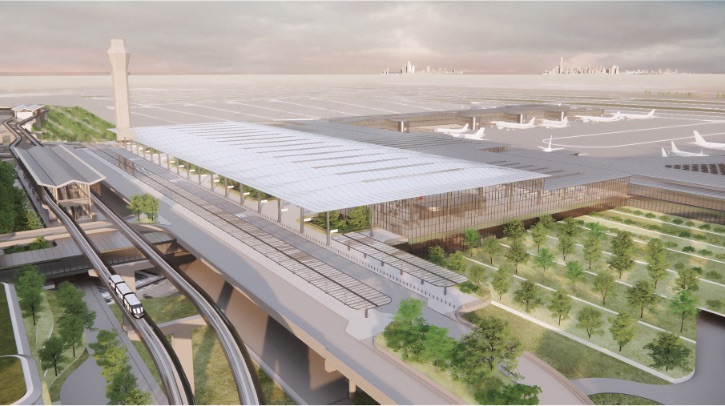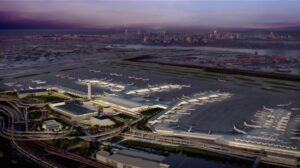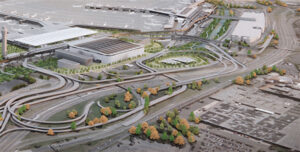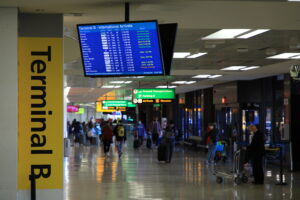Infra
VIDEO: Port Authority of New York and New Jersey unveils plan to reimagine Newark Liberty International – Passenger Terminal Today

The Port Authority of New York and New Jersey (PANYNJ) has unveiled the EWR Vision Plan, a blueprint that sets the course for Newark Liberty International Airport’s continued development over the coming decades to accommodate passenger growth.
EWR Vision Plan
The port authority expects to begin a two- to three-year planning process in 2025 for major elements of the redevelopment, including cost projections and project delivery alternatives.
The EWR Vision Plan was developed in partnership with design firm Arup and architecture firm Skidmore, Owings & Merrill (SOM). It charts a comprehensive reimagining of the airport, complete with modern terminals and infrastructure, a more intuitive roadway network, and a redesigned taxiway network to accommodate more aircraft and reduce delays.
The blueprint is intended to enable the airport to handle future growth, while serving the evolving needs of passengers, airlines and the surrounding community. It was developed following outreach to airport tenants, operational partners and the public.
The plan calls for building a new international terminal to replace the current Terminal B, while enhancing Terminal C to improve the customer experience. Both would complement the airport’s new Terminal A which opened in January 2023, which could also see further expansion. The spacious, streamlined terminals would enable the airport to accommodate continued growth in passenger volume while leaving space for further expansion as needed.

The plan also envisions improving the airport’s operations with a more efficient and resilient taxiway network while accommodating the industry trend toward larger aircraft. The new network would increase parking capacity and flexibility for aircraft while creating redundancies to minimize delays during irregular operations, and incorporate additional deicing facilities, meaning aircraft can push off from gates more quickly. It would also include the industry’s latest safety standards, increasing straight taxiway segments and minimizing the need for crossings.

To develop the airport’s landside operations, the blueprint looks to transform the airport’s vehicular and multi-modal access, prioritizing efficiency and convenience for all users. Alongside terminal buildings, frontages would be expanded to meet industry standards, providing ample space for passenger waiting, loading and unloading while minimizing walking distances. AirTrain access would be simplified, while connectivity and amenities for cyclists, pedestrians and service vehicles would be improved. The roadway network would also be streamlined to reduce decision points and separate major flows with independent circulation for each terminal.
Updating legacy infrastructure
Much of the 96-year-old airport’s current infrastructure dates to the 1970s, when Terminals B and C and the original Terminal A were built. Today, the airport’s legacy infrastructure struggles to meet the needs of modern air travel, especially as the airport’s passenger volume grows. A record 49 million passengers passed through the airport in 2023. According to the airport, major recurring issues, including insufficient terminal capacity, congested roadways, and airside delays often lead to “inefficient operations and a subpar passenger experience”. 
Through the vision plan, the port authority aims to accommodate future growth while delivering a “world-class experience from curb to gate”. The vision plan pursues a phased approach, minimizing the impact on airport operations while fostering new business opportunities for the local community. The enhancements would also provide new opportunities for the port authority to advance the agency’s sustainability efforts, furthering its commitment to reach net-zero carbon emissions by 2050 while assisting its operational partners in achieving the same goal. The plan aims to build on the success of the airport’s new Terminal A, which received the ‘best new airport terminal in the world’ award from Skytrax.
PANYNJ airport redevelopments
In 2015, a comprehensive plan to construct a whole new LaGuardia Airport was unveiled, with the goal of creating a 21st century passenger experience featuring modern customer amenities, state-of-the-art architecture, more spacious gate areas and a unified terminal system. The US$8bn project broke ground in 2016 and was substantially completed in 2022.
In January 2017, the JFK Vision Plan was announced to transform JFK. The vision plan provides a strategic framework for the port authority and its partners to completely redevelop, modify and expand existing facilities and infrastructure. The US$9.5bn development of New Terminal One, which will anchor the airport’s south side, broke ground in September 2022. A new US$4.2bn Terminal 6, which will connect with Terminal 5 to create an anchor terminal on the airport’s north side, broke ground in February 2023. The US$1.5bn expansion of Terminal 4, led by Delta Air Lines and JFK International Air Terminal (JFKIAT), is substantially complete; and the US$400m expansion of Terminal 8, led by American Airlines, which operates the terminal, was completed in November 2022. All of the privately financed terminal projects, combined with the port authority’s roadway, parking and infrastructure projects, represent a US$19bn transformation of JFK.
For more of the top insights into the future of Newark Liberty Airport, read Passenger Terminal World’s exclusive feature “Surprise Package” on the sophisticated digital journey that awaits travelers at the new Terminal A, here.











